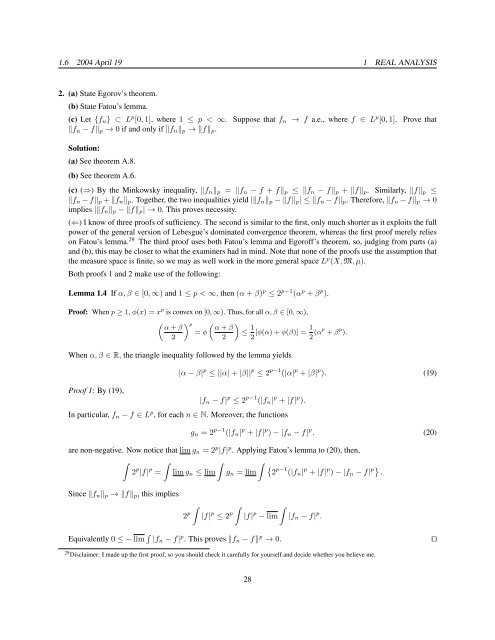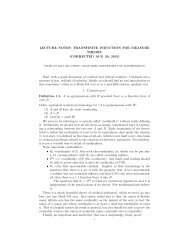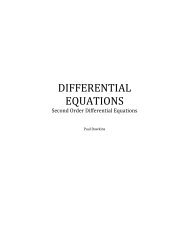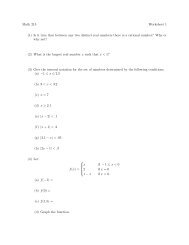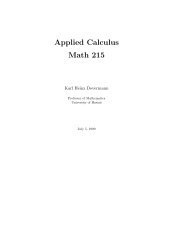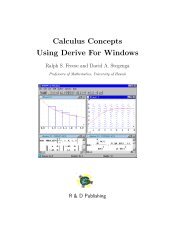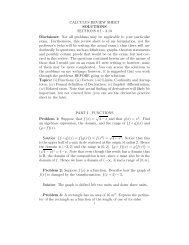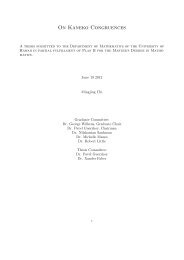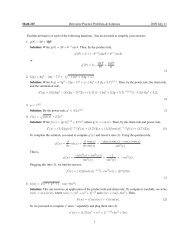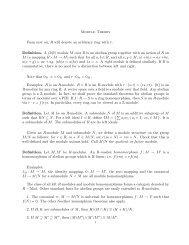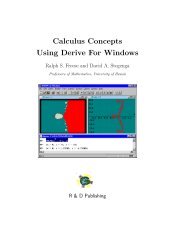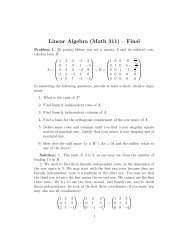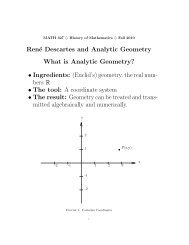Problems and Solutions in - Mathematics - University of Hawaii
Problems and Solutions in - Mathematics - University of Hawaii
Problems and Solutions in - Mathematics - University of Hawaii
Create successful ePaper yourself
Turn your PDF publications into a flip-book with our unique Google optimized e-Paper software.
1.6 2004 April 19 1 REAL ANALYSIS<br />
2. (a) State Egorov’s theorem.<br />
(b) State Fatou’s lemma.<br />
(c) Let {fn} ⊂ L p [0, 1], where 1 ≤ p < ∞. Suppose that fn → f a.e., where f ∈ L p [0, 1]. Prove that<br />
fn − fp → 0 if <strong>and</strong> only if fnp → fp.<br />
Solution:<br />
(a) See theorem A.8.<br />
(b) See theorem A.6.<br />
(c) (⇒) By the M<strong>in</strong>kowsky <strong>in</strong>equality, fnp = fn − f + fp ≤ fn − fp + fp. Similarly, fp ≤<br />
fn − fp + fnp. Together, the two <strong>in</strong>equalities yield |fnp − fp| ≤ fn − fp. Therefore, fn − fp → 0<br />
implies |fnp − fp| → 0. This proves necessity.<br />
(⇐) I know <strong>of</strong> three pro<strong>of</strong>s <strong>of</strong> sufficiency. The second is similar to the first, only much shorter as it exploits the full<br />
power <strong>of</strong> the general version <strong>of</strong> Lebesgue’s dom<strong>in</strong>ated convergence theorem, whereas the first pro<strong>of</strong> merely relies<br />
on Fatou’s lemma. 29 The third pro<strong>of</strong> uses both Fatou’s lemma <strong>and</strong> Egor<strong>of</strong>f’s theorem, so, judg<strong>in</strong>g from parts (a)<br />
<strong>and</strong> (b), this may be closer to what the exam<strong>in</strong>ers had <strong>in</strong> m<strong>in</strong>d. Note that none <strong>of</strong> the pro<strong>of</strong>s use the assumption that<br />
the measure space is f<strong>in</strong>ite, so we may as well work <strong>in</strong> the more general space L p (X, M, µ).<br />
Both pro<strong>of</strong>s 1 <strong>and</strong> 2 make use <strong>of</strong> the follow<strong>in</strong>g:<br />
Lemma 1.4 If α, β ∈ [0, ∞) <strong>and</strong> 1 ≤ p < ∞, then (α + β) p ≤ 2 p−1 (α p + β p ).<br />
Pro<strong>of</strong>: When p ≥ 1, φ(x) = x p is convex on [0, ∞). Thus, for all α, β ∈ [0, ∞),<br />
p <br />
α + β α + β<br />
= φ ≤<br />
2<br />
2<br />
1<br />
1<br />
[φ(α) + φ(β)] =<br />
2 2 (αp + β p ).<br />
When α, β ∈ R, the triangle <strong>in</strong>equality followed by the lemma yields<br />
Pro<strong>of</strong> 1: By (19),<br />
|α − β| p ≤ ||α| + |β|| p ≤ 2 p−1 (|α| p + |β| p ). (19)<br />
|fn − f| p ≤ 2 p−1 (|fn| p + |f| p ).<br />
In particular, fn − f ∈ L p , for each n ∈ N. Moreover, the functions<br />
gn = 2 p−1 (|fn| p + |f| p ) − |fn − f| p . (20)<br />
are non-negative. Now notice that lim gn = 2p |f| p . Apply<strong>in</strong>g Fatou’s lemma to (20), then,<br />
<br />
2 p |f| p <br />
=<br />
<br />
lim gn ≤ lim<br />
<br />
2p−1 gn = lim (|fn| p + |f| p ) − |fn − f| p .<br />
S<strong>in</strong>ce fnp → fp, this implies<br />
2 p<br />
<br />
|f| p ≤ 2 p<br />
<br />
|f| p <br />
− lim<br />
|fn − f| p .<br />
Equivalently 0 ≤ − lim |fn − f| p . This proves fn − f p → 0. ⊓⊔<br />
29 Disclaimer: I made up the first pro<strong>of</strong>, so you should check it carefully for yourself <strong>and</strong> decide whether you believe me.<br />
28


